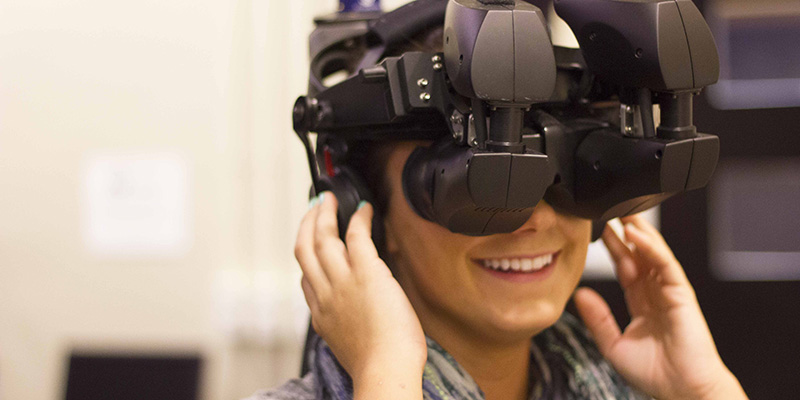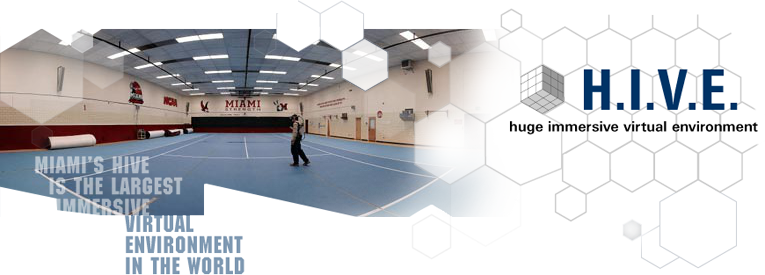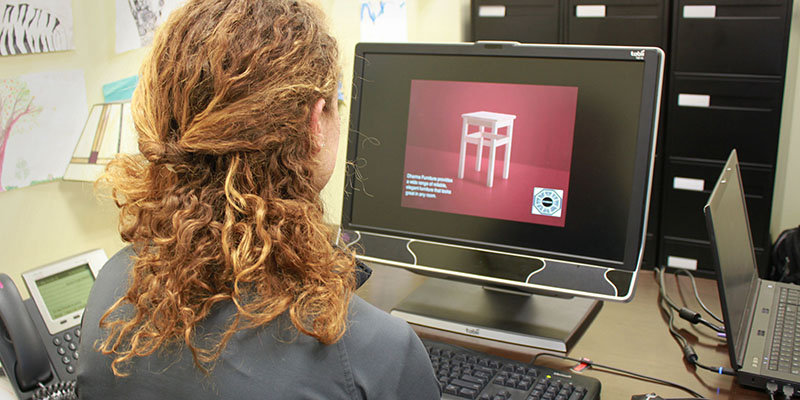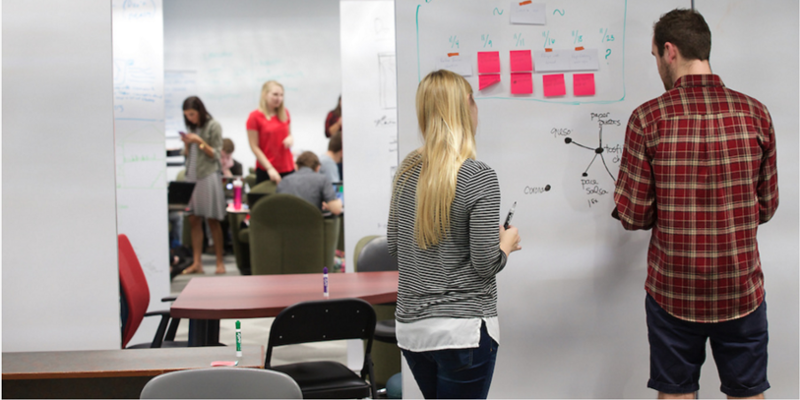Advanced Facilities | About | Dept of Emerging Technology in Business and Design
Building on Miami University’s commitment to excellent undergraduate education, ETBD faculty work with students to advise them in a tailored path through the curriculum. Faculty also run various international programs to work with clients in other cultures (past trips have included workshops in China, Ireland, and the United Kingdom). Faculty coach students during key industry opportunities, including the annual Game Developers Conference.
Our spaces are as diverse as our faculty and students. Spaces are intentionally spread across campus, forcing our students to “rub shoulders” with students outside of ETBD in order to gain their perspective on the technology.
ETBD students have done some amazing work using this equipment. They’ve built hospital simulations to help nurses improve their evacuation of neonatal facilities. They have worked with faculty to build geo-tracking devices that enable augmented and virtual reality to exist outside of a laboratory. They have designed and tested cutting-edge augmented reality applications. They have even built custom game controllers to help children with autism.
Beyond cutting-edge technology, we also provide more traditional tools to ETBD students free of charge. Students can borrow SLR cameras, Android tablets, iPads, Android phones, iPhones, and other contemporary technology for use in building and testing their work.
John Smale Visualization Lab and Center

Location: 207 Laws Hall
Director: Professor Eric Hodgson
Very generous donations from alumni John Smale and Michael Armstrong have funded a research and innovation center devoted to visualization and virtual reality. The John Smale Interactive Visualization Lab and Center along with another research facility, the Huge Immersive Virtual Environment (HIVE), provides a complete range of visualization tools for students, faculty, and industry partners.
Through various courses and projects, the Smale Interactive Visualization Center provides real-world industry experience to Miami University students.
Equipment
- 4-walled, virtual reality CAVE
- Z‑space 3D table
- iBox 3D viz
- 3D scanners
- 6 Occulus Rifts (DK1+2)
- Hydras
- LEAP motions
- motion capture suit
The Center’s purposes reach across traditional academic boundaries to serve all academic divisions at Miami. Leading these efforts is Center Director Eric Hodgson, ETBD professor, Miami alumnus, and member of the HIVE research team.
The Center's partner EON Reality, Inc. provides software, hardware, development assistance, and support.
Huge Immersive Virtual Environment (HIVE)

Location: Phillips Hall gymnasium
The HIVE (Huge Immersive Virtual Environment) is the largest physical space dedicated to virtual environments in the world. Around the perimeter of the gym are 3D motion trackers, which determine the position of users within the space. Users wear head-mounted virtual reality displays. As they move throughout the space, the 3D motion trackers report out to the software that the participants are moving through the virtual space.
Specifically, the lab features the following motion capture technology:
- An 8-camera system from Vicon, Inc. Cameras can capture at 500 frames/sec. at full resolution.
- Software, including
- Vicon Nexus: Life sciences motion capture
- Vicon Blade: Animation
- Vicon Bodybuilder: Biomechanical modeling
- Vicon Polygon: Interactive multimedia reports
Center for Research in User Experience (CRUX)

Location: 2034 Farmer School of Business
Traditionally, designers and marketers had to rely on crude methods to discern how consumers viewed material, interacted with tools, or played games. However, a toolset has emerged which allows designers and marketers to track the gaze of their users. This eye-tracking hardware and usability software is state-of-the-art. In the Usability Lab, students and faculty collaborate to track gaze on a variety of hardware configurations including traditional desktop computers, tablets and mobile devices. The Usability Lab even contains advanced eye-tracking glasses which allow us to monitor what users look at as they move through physical spaces.
Specifically, the lab features the following industry-standard usability software and software:
- Morae User Testing and Market Research Software
- Tobii Eye-tracking Monitors
- Lyris HQ Web Analytics Software
CRUX
The Usability Lab is also the primary research facility for the Center of Research in User Experience (CRUX). CRUX partners with real-world clients to help them better understand how their users experience and encounter their company and brand in digital media spaces. CRUX leverages faculty who are experts in the fields of marketing, technical writing, cross-cultural communications and design. These experts are trained in a wide range of usability methodologies.
In addition, CRUX has focus group facilities for moderated discussions and evaluation rooms where clients can watch users interact with their products. With the portable usability lab option, CRUX can even travel to visitors to evaluate their experiences where they work or live. This array of technologies and facilities allows CRUX faculty and students to generate a variety of report formats/types, including usability, task analysis, video highlights, and eye-tracking.
Co-Lab

Our recently opened Co-Lab space is unique within higher education. In 2015, we took three separate rooms and replaced the walls between them with barn doors. All the walls were covered with whiteboard paint, and we added modular furniture. The Co-Lab also features a small library of books and resources as well as a kitchenette. The result is a collaboration space unlike any other on campus, one that is reminiscent of the spaces used by our top performing industry partners.
However, the space is only half the story. This collaborative lab enables us to offer more and more classes where collaboration is the centerpiece. Piloted in 2015 and rolled out in 2016, ETBD offers the Co-Lab Course, a unique course designed to enable students to work collaboratively on projects of their choosing while being coached and mentored directly by faculty and industry mentors. We believe this “mini” version of the hugely successful Armstrong Interactive Practicum Capstone (IMS 440) will allow sophomores and juniors to begin using their skills to collaborate on emerging technology to build portfolio pieces that will push the envelope of what’s possible.
During the pilot run of the course, students developed solutions as diverse as health tracking tools for students struggling with depression in collaboration with medical researchers, Apple Watch apps to help with crisis while flying, Arduino-powered physical interfaces and cinematic virtual reality tours of Cincinnati for the MLB’s All Star Game.
Also, being within the ETBD space, we are able to provide our students 24/7 keycard access to this space so they can collaborate more easily outside of scheduled class time.
Games Lab
Location: 27 King Library
This hybrid classroom/lab is used primarily for Game classes. One half of the room features a classroom space with 25 dual boot iMac workstations with dual monitors as well as dual 3D-capable projectors. In the other half, couches surround HD displays with classic and contemporary gaming consoles. This configuration allows students to seamlessly engage in the theory and practice of gaming.
For instance, a games professor may be discussing a classic Atari 2600 game. If students are not familiar with it, they can play the game in the same space. Or, if students are designing and developing a game, they can write it on one of the workstations, then play it while sitting on a couch.
Shared Classrooms
Armstrong 3D Visualization Classroom
2040 Farmer School of Business
This classroom/lab contains a 16′ x 9′ visualization wall with HD active stereoscopic 3D.
Armstrong Videoconferencing Classroom
9 Benton Hall | Shared with CSA
This classroom is used for distance-based interaction with clients, guest lecturers, faculty, and students. The room has a multi-camera, multi-screen tandberg videoconferencing system that allows the entire classroom to participate. It also had dual projection on the front and back of the room and business-style furnishings for a professional sense.
Digital Art and Design Classroom
200 Hiestand | Shared with ART
This classroom is used for ETBD digital design classes. It has 22 dual boot iMac desktops, 3 PCs, and collaboration space.
Engaging Technology Lab
214 McGuffey Hall | Owned by EHS
This lab has a number of high-end development worksuites, projection walls, smartboards, Oculus Rifts (DK2s), Wacom Cintiqs, paper prototyping kits, MIDI controllers, mobile devices, etc.
More about the Engaging Technology Lab
Game Development Classroom
8 Benton Hall | Owned by SEAS
This classroom/lab is used XBOX 360 development. It has 25 Windows 7 computers each with an XBOX 360 and XNA development tools.
Motion Capture Lab
Phillips Hall | Shared with KNH
This fixed motion capture lab has Vicon hardware and software for motion capture, biomechanics, and Blade animation software. We also have access to a motion capture spandex suit that can capture motion at any location.
